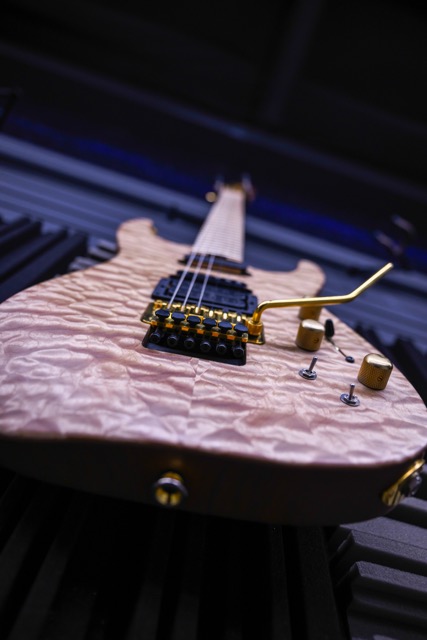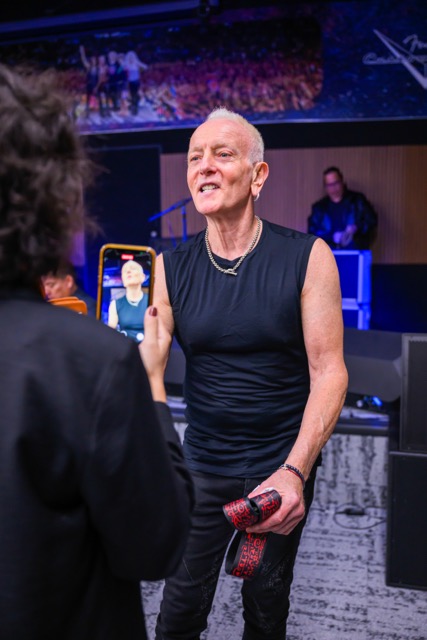Def Leppardʻs Phil Collen Has Set a Tone in Guitar Excellence
For video click HERE
BY JIM FORBES/Publisher
It was a “Jazz Box” in the days of the Big Bands. A “Guitfiddle” to Southerners. Kiwis go with “Gat,” while in the freezing Fjords of Finland, “Keppi” is the word. That translates to stick, the Finns a bit more sedate than the British and American rockers, who get to the point. It’s an “Axe.”
“Itʻs a tool. A tool for expression,” Def Leppard co-lead guitarist (Axe Man) Phil Collen expresses matter-of-factly. “When I was a kid, it was out of reach.”
The son of a truck driver and a stay-at-home mom, a teen factory worker in his native London himself, a guitar was more luxury than a need.
“Jackson’s made my guitar dream come true.”
That is not Jackson as in Michael, though Def Leppard did sit right behind the King of Pop on the charts in the 80ʻs. Specifically, Jackson Guitars, part of the Fender Musical Instruments Corporation family of brands.
Five decades after an entry-level guitar seemed “out of reach”, the famed Fender, supplier of the Guitfiddle, Jazz Box, and Keppi, to so many of the historically great Axe men and women for generations, has dedicated the Phil Collen Performance Room in its U.S. factory headquarters in Corona, to the kid who only dreamed of owning a simple six-string.
“Collen has been a dedicated endorsee of Jackson Guitars—one of FMIC’s premier brands—for more than 30 years,” the company stated in its dedication. “He has developed a strong connection with the Corona facility, having spent extensive time there over the years.”

The tide turned fifty-four hundred miles away across the pond when the East End Londoner attended his first concert gig, Deep Purple, and experienced a timeless epiphany of millions. “I saw Ritchie Blackmore playing his (Fender) Strat (ocaster) and I was like F$%*(^%, I want to do that. It was so expressive. And that was the thing, I didnʻt really know what expression was.”
But the hook was in, and he obtained his first guitar at the age of 16. His talent evolved, his technical skills are revered today, and his exposure grew with local bands. Within a few years, Collen was playing the Marquee Club in London’s West End, performing on the stage where so many greats from Muddy Waters to the Rolling Stones, Jimi Hendrix to Pink Floyd rolled. If you can think of them, they quite possibly played the Marquee.
Five years after his first guitar, on his 21st birthday, “My mom got me a black Fender Strat with a maple neck because Ritchie Blackmore played one.” And, Collen relates Blackmore actually played the gifted axe on stage at the Marquee one night, while fawning over Collen’s girlfriend.
He treasured that Strat, but didn’t dare modify it himself. Not until a rising Eddie Van Halen came to London on Van Halenʻs first headline tour. “Iʻve got this Strat and it’s great, but I donʻt want to cut any holes in it. “You wonʻt be happy with that guitar until you change that pickup. Eddie Van Halen told me this. So, I changed it.”
Out with the old single coil pickup, in with the larger double coil humbucker. Now in the studio with his new band Def Leppard. “Every song that you hear, ‘Animal’, ‘Pour Some Sugar on Me’, all of that stuff is that guitar.”
“Personally me, I like fire in guitars… I had 3 Telecasters made for me with the fattest neck that Jackson or Fender ever made. Everybody laughs at me, well, you canʻt play this. Because of the extra wood the tone and everything, itʻs my favorite guitar.”
The wood. Don’t let the new Taylor Swift hit distract you.
“Wood has always been my thing,” Michael Kotzen, Fender’s Director, Supply Chain – Wood, confides. “My dream job has always been sourcing wood because I’m a lifelong woodworker.”
A dream job that takes him around the globe in search of the best. “I just came back 2 months ago from a week trip to Cameroon to do some ebony sourcing. That was amazing. Been to Fiji to look at plantation grown mahogany because we are really interested in making sure we’re not only sustainable but ethically sourced, legally sourced.”
It’s not just about aesthetics, but acoustics.
“There’s a lot of tonal impacts. For example, we use a lot of roasted wood now because the guitar players love the roasted ash, for example. There’s a model that Phil Collen plays that has a roasted ash body.” Yes, Kotzen says, roasted like dinner, in a different style oven.
“We have an R&D sound room here,” for the artists, Kotzen explains. “In the old days, theyʻd look at which one was prettiest and that’s what sounded best.”
So to counter that, Kotzen reveals, they do tests, paint the models black, and issue blindfolds. Collen scored an A+. “We gave him the different guitars and he called it out every single one. “I think this is the roasted neck.” “Yes, it is.” “And this is the regular neck.” It was amazing.”
“A Stratovarius Violin, for example, or a very old guitar. Some of my Jacksonʻs are 40 years old. What happens is the moisture dries out, and it leaves little caves, like capillaries, inside the wood,” Collen described. “That’s what happens. That process (roasting) kind of emulates that. It kinda gets rid of the moisture, and therefore, there’s more vibration and you get a sweeter sound.”
The dedication of the Phil Collen Performance Room amplifies the harmonic, collaborative artistry among those who ply the crafts, trades, and notes that strike a symphonic chord.
Editors Note: The author was a producer & the narrator of VH1ʻs Behind The Music, which featured Def Leppard in a 1998 episode.

For More Arts and Entertainment News Visit www.zapinin.com


